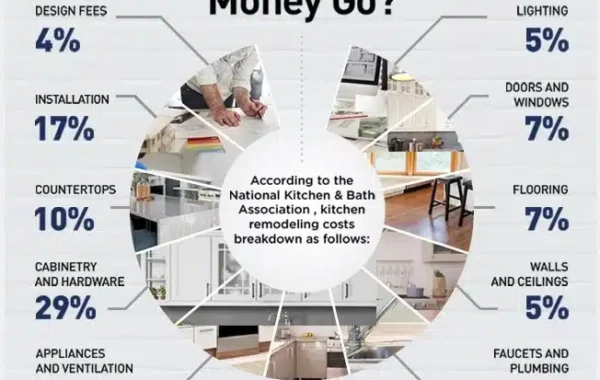Sustainable Remodeling Ideas for Homes in Oak Brook
Oak Brook, Chicago Suburbs, a community known for its lush landscapes and stately homes, is increasingly embracing sustainable living. Remodeling presents a prime opportunity to enhance not only the aesthetics and functionality of your home but also its environmental footprint. This article explores practical and inspiring sustainable remodeling ideas tailored to Oak Brook homes, balancing luxury and eco-consciousness.
Understanding Sustainable Remodeling
Sustainable remodeling goes beyond simply using “green” materials. It’s a holistic approach considering the entire lifecycle of materials, energy efficiency, water conservation, and indoor air quality. It’s about creating a healthier, more comfortable home that treads lightly on the planet.
The Benefits of Going Green
- Reduced Utility Bills: Energy-efficient upgrades directly translate into lower monthly expenses.
- Improved Indoor Air Quality: Healthier materials and ventilation systems minimize harmful pollutants.
- Increased Home Value: Sustainable features are increasingly desirable to homebuyers, boosting your property’s appeal.
- Environmental Responsibility: Contribute to a healthier planet by reducing your carbon footprint.
- Enhanced Comfort: Sustainable materials often offer superior insulation and soundproofing, creating a more comfortable living environment.
Energy Efficiency Upgrades
Energy efficiency forms the cornerstone of sustainable remodeling. In Oak Brook’s climate, prioritizing these upgrades is crucial.
High-Performance Windows and Doors
Replacing old, drafty windows and doors with energy-efficient models is one of the most impactful upgrades. Look for windows with low-E coatings, argon gas fills, and proper weather stripping. Consider fiberglass or wood-clad frames for durability and insulation.
Insulation Enhancements
Proper insulation is vital for maintaining a comfortable temperature and reducing energy consumption. Upgrade your attic, walls, and crawl spaces with eco-friendly insulation options like recycled denim, cellulose, or spray foam (closed-cell for moisture resistance). Remember to air-seal any cracks or gaps to prevent air leaks; a blower door test can identify these.
Smart HVAC Systems
Install a high-efficiency HVAC system with smart thermostats. These systems use advanced technology to optimize heating and cooling based on occupancy and weather patterns. Consider geothermal heating and cooling for a highly sustainable, albeit more expensive, long-term solution. Regular maintenance will maximize efficiency and lifespan.
Solar Panels
Take advantage of Chicago Suburbs’s solar incentives and consider installing solar panels. This can significantly reduce or even eliminate your reliance on grid electricity. A professional assessment will determine the optimal panel placement and system size for your home’s energy needs and roof orientation. Don’t forget to explore battery storage options for backup power and increased self-sufficiency.
Water Conservation Strategies
Conserving water is another key aspect of sustainable remodeling, especially given increasing concerns about water scarcity.
Low-Flow Fixtures
Replace traditional faucets, showerheads, and toilets with low-flow models. These fixtures use significantly less water without sacrificing performance. Look for WaterSense-certified products to ensure water savings. A dual-flush toilet can be a great choice for bathrooms, offering different flush volumes for liquid and solid waste.
Rainwater Harvesting
Collect rainwater in barrels or cisterns for irrigating your lawn and garden. This reduces your reliance on municipal water and conserves a precious resource. Ensure your system complies with local regulations and that the collected water is not used for potable purposes.
Smart Irrigation Systems
Install a smart irrigation system that automatically adjusts watering schedules based on weather conditions and soil moisture levels. This prevents overwatering and reduces water waste. Drip irrigation is particularly efficient for garden beds and landscaping.
Sustainable Materials and Finishes
Choosing eco-friendly materials and finishes is crucial for minimizing your environmental impact and improving indoor air quality.
Reclaimed and Recycled Materials
Incorporate reclaimed wood, recycled glass, and other recycled materials into your remodeling project. These materials add character and reduce the demand for new resources. Local salvage yards are a great source for unique and sustainable finds. For example, reclaimed barn wood can be used for accent walls or flooring, adding rustic charm.
Natural and Non-Toxic Finishes
Opt for paints, stains, and sealants that are low-VOC (volatile organic compounds) or VOC-free. These products release fewer harmful chemicals into the air, improving indoor air quality. Consider natural alternatives like milk paint or plant-based oils.
Sustainable Flooring
Choose sustainable flooring options like bamboo, cork, linoleum, or reclaimed hardwood. These materials are renewable, durable, and often offer unique aesthetic qualities. Bamboo is a rapidly renewable resource, while cork is harvested without harming the tree. Linoleum is made from natural materials like linseed oil and jute.
Designing for Sustainability
Thoughtful design is integral to creating a truly sustainable home.
Passive Solar Design
Maximize natural light and solar heat gain by strategically orienting windows and using overhangs to shade the interior during the summer months. This reduces the need for artificial lighting and heating. South-facing windows are ideal for passive solar heating in Oak Brook’s climate.
Natural Ventilation
Design for natural ventilation by incorporating operable windows and skylights that allow fresh air to circulate. This reduces reliance on air conditioning and improves indoor air quality. Consider a whole-house fan to exhaust warm air during the evenings.
Landscaping for Sustainability
Choose native plants that require less water and maintenance. Create shade with trees to reduce cooling costs. Consider a green roof to insulate your home and reduce stormwater runoff. Native plants support local ecosystems and attract pollinators.
Working with Sustainable Remodeling Professionals
Finding experienced and reputable professionals is essential for a successful sustainable remodeling project.
Research and Select Contractors Carefully
Look for contractors with experience in sustainable building practices and certifications like LEED (Leadership in Energy and Environmental Design). Ask for references and review their past projects. Ensure they are licensed, insured, and bonded. Don’t hesitate to ask about their specific experience with green building techniques and materials.
Communicate Your Goals Clearly
Clearly communicate your sustainability goals to your contractor and designer. Discuss your budget, priorities, and desired outcomes. A well-defined plan will ensure that your project meets your expectations. Consider creating a written agreement outlining the specific sustainable practices to be implemented.
Verify Material Certifications
Ensure that the materials used in your project are certified by reputable organizations like the Forest Stewardship Council (FSC) for wood products and the Green Building Council for overall building materials. This verifies that the materials meet specific environmental standards. Request documentation from your contractor to confirm the certifications.
Conclusion
Sustainable remodeling offers a compelling path to creating a more comfortable, valuable, and environmentally responsible home in Oak Brook. By embracing energy efficiency, water conservation, sustainable materials, and thoughtful design, you can transform your living space while minimizing your impact on the planet. As you embark on your remodeling journey, remember that even small changes can make a significant difference. Armed with these ideas, you’re well-equipped to create a sustainable haven that blends seamlessly with the natural beauty of Oak Brook.

